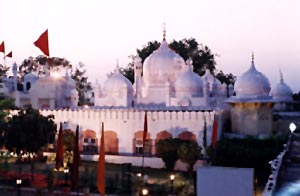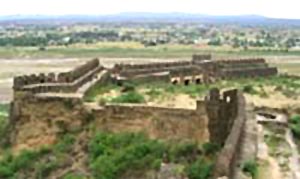With roots in the times of the Mahabharata Haryana is one of the most sought after pilgrimage destinations in India. Amongst the many religious places Kurukshetra stands out because of its antiquity.
According to the Puranas, Lord Brahma created the universe from this site. Also the legends of Sati and Lord Shiva are related to Kurukshetra. But above all it is remembered as the land of the Bhagwad Gita. It is the same place where Lord Krishna enlightened Arjuna and revealed Himself as the lord of the world. As a result the importance of this place is immense for a Hindu pilgrim. in total this place has 360 places that are religiously and historically significant.
 It is located on the Delhi-Ambala National Highway No.1. As the tourists set their feet on this sacred land they will come across a lot of temples. The first is the Brahma Sarover, a water body. In the middle of this stands the Sarveshwar Mahadev Temple in the shape of a lotus. It is dedicated to Lord Shiva. According to legends this site was created by Lord Brahma himself.
It is located on the Delhi-Ambala National Highway No.1. As the tourists set their feet on this sacred land they will come across a lot of temples. The first is the Brahma Sarover, a water body. In the middle of this stands the Sarveshwar Mahadev Temple in the shape of a lotus. It is dedicated to Lord Shiva. According to legends this site was created by Lord Brahma himself.
Around this holy shrine the travelers will have the Lakshmi Narayan Temple to explore too. The summit of the temple is visible even from a distance and the classic architecture of the shrine belongs to the 18th century. This throws a lot of light on the history of the temple.
At a distance of around a kilometer is the Sannehit Sarover. This too is closely associated with Lord Brahma and pilgrims come here to take a dip in its holy waters. Most of the prayers are offered here during amavasya or New Moon. Holy shrines dedicated to Dhruva Narayan, Mother Goddess Durga and Lord Hanuman are to be found here. This was the place where aswamedhya yajnas were once held.
This land, Kurukshetra, is of great significance to the Sikhs. A number of Sikh gurus have visited this place time and again. As a result the travelers will come across several Gurudwaras. Some of the popular Sikh pilgrimage sites include the place where Guru Nanak stayed; a gurudwara dedicated to the 6th sage, Guru Hargobind and finally Rajghat, a Sikh place of worship dedicated to Guru Gobind Singh.
Beyond Kurukshetra lies another premier Hindu pilgrimage site of Thanesar. It has been named after "Sthanesvar" which means the abode of the God. This place is famous for the Sthanesvar Mahadev temple and the Ma Bhadra Kali Temple.
A Gurudwara that lies opposite the Sthanesvar temple marks the spot sanctified by the visit of Guru Tegh Bahadur.
 The foothills of the Siwalik house a number of temples dedicated to several Mother Goddesses. In India Adi Shakti (power) ha always been worshipped in the female form. in Haryana the Mother Goddess has a special place on the hearts of the people.
The foothills of the Siwalik house a number of temples dedicated to several Mother Goddesses. In India Adi Shakti (power) ha always been worshipped in the female form. in Haryana the Mother Goddess has a special place on the hearts of the people.
Haryana shares its capital city, Chandigarh, with Punjab. Undoubtedly it is a modern city yet it is deeply rooted in its customs and traditions. As a result the pilgrims will come across a number of temples in and around the city.
Mansa Devi, 8 km away from the Chandigarh bus stand, was built by the Maharaja of Patiala. The temple is admired because the Goddess is believed to grant wishes.
10 kilometers away from this particular shrine is the Chandi Mandir. It is considered as the Siddh Peetha.
The tourists can also check out the ruins of the Bhima Devi at Pinjore. It is also an important archaeological site that dates back to the 11th century.
 Kalka lies on the Ambala-Shimla national highway. Here the famous temple of Kalka Devi is situated.
Kalka lies on the Ambala-Shimla national highway. Here the famous temple of Kalka Devi is situated.
Apart from the Hindu pilgrimage sites there is the Kabuli Shah mosque that was built by Babur after his victory over Ibrahim Lodhi. It was named after his wife Kabuli Begum. Six years later Humayun defeated Salim Shah and then he built a platform called Chabutara Fateh Mubarak around the mosque. The mosque is dotted with chambers on two sides and an inscription in Persian language.



















